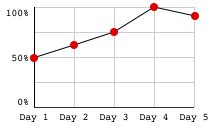Understanding Mean: From Basics to Advanced Applications Dive into the world of mean calculations, from simple averages to complex statistical analyses. Master key concepts, interpret data spread, and apply your knowledge to real-world scenarios.
Free to Join!
Easily See Your Progress
 We track the progress you've made on a topic so you know what you've done. From the course view you can easily see what topics have what and the progress you've made on them. Fill the rings to completely master that section or mouse over the icon to see more details.
We track the progress you've made on a topic so you know what you've done. From the course view you can easily see what topics have what and the progress you've made on them. Fill the rings to completely master that section or mouse over the icon to see more details.Make Use of Our Learning Aids
Earn Achievements as You Learn
 Make the most of your time as you use StudyPug to help you achieve your goals. Earn fun little badges the more you watch, practice, and use our service.
Make the most of your time as you use StudyPug to help you achieve your goals. Earn fun little badges the more you watch, practice, and use our service.Create and Customize Your Avatar
 Play with our fun little avatar builder to create and customize your own avatar on StudyPug. Choose your face, eye colour, hair colour and style, and background. Unlock more options the more you use StudyPug.
Play with our fun little avatar builder to create and customize your own avatar on StudyPug. Choose your face, eye colour, hair colour and style, and background. Unlock more options the more you use StudyPug.
Introduction to Mean Absolute Deviation
Welcome to our exploration of mean absolute deviation (MAD), a crucial concept in statistics! MAD is a powerful tool that helps us understand how spread out our data is from the average. It's like measuring how consistent our data points are. Imagine you're looking at test scores - MAD tells you if everyone scored similarly or if there were big differences. The introduction video we'll watch shortly does a fantastic job of breaking this down visually. It's especially great for visual learners! MAD is super important because it gives us a clear picture of data spread, which is essential in many fields, from finance to science. Unlike some other measures, MAD is less affected by extreme values, making it really useful for certain types of data. As we dive deeper, you'll see how MAD can help you make sense of data sets and draw meaningful conclusions. Ready to become a MAD expert?
Calculate the mean of each set of data. Round your answer to the nearest tenth. 4, 8, 9, 7, 7
Step 1: Understanding the Mean
The mean is a measure of the center of a data set. It is calculated by summing all the numbers in the data set and then dividing by the number of data values. This gives us an average value that represents the central point of the data set.
Step 2: Summing the Data Values
To find the mean, the first step is to sum up all the numbers in the data set. In this example, the data set is 4, 8, 9, 7, and 7. We need to add these numbers together:
4 + 8 + 9 + 7 + 7
Let's calculate the sum:
4 + 8 = 12
12 + 9 = 21
21 + 7 = 28
28 + 7 = 35
So, the sum of the data values is 35.
Step 3: Counting the Number of Data Values
Next, we need to determine how many data values are in the set. In this example, we have the following numbers: 4, 8, 9, 7, and 7. Counting these, we find that there are 5 data values.
Step 4: Dividing the Sum by the Number of Data Values
Now that we have the sum of the data values (35) and the number of data values (5), we can find the mean by dividing the sum by the number of data values:
Mean = Sum of data values / Number of data values
Mean = 35 / 5
Let's perform the division:
35 ÷ 5 = 7
Step 5: Rounding the Mean
In this example, the mean is already a whole number (7), so there is no need to round to the nearest tenth. However, if the mean were a decimal, we would round it to the nearest tenth.
Conclusion
By following these steps, we have calculated the mean of the data set 4, 8, 9, 7, 7. The mean is a useful measure of the central tendency of a data set, providing a single value that summarizes the entire set of numbers.
-
What is Mean Absolute Deviation (MAD)?
Mean Absolute Deviation (MAD) is a statistical measure that calculates the average distance between each data point and the mean of a dataset. It provides insight into data spread and consistency, helping to understand how much variation exists within a set of values.
-
How is MAD different from standard deviation?
While both measure data spread, MAD uses absolute values of deviations, making it less sensitive to outliers. Standard deviation squares deviations, giving more weight to larger differences. MAD is often easier to interpret as it's in the same units as the original data.
-
What are the steps to calculate MAD?
To calculate MAD: 1) Find the mean of the dataset. 2) Calculate the absolute difference between each data point and the mean. 3) Sum these absolute differences. 4) Divide the sum by the number of data points.
-
In which fields is MAD commonly used?
MAD is widely used in finance for risk assessment, manufacturing for quality control, weather forecasting for prediction accuracy, economics for analyzing market trends, and healthcare for patient monitoring and clinical trials.
-
Why is MAD considered robust against outliers?
MAD is robust against outliers because it uses absolute values rather than squared differences. This means extreme values have less impact on the final result compared to measures like standard deviation, making MAD particularly useful for datasets with potential outliers.
When delving into the concept of mean in mathematics, it's crucial to have a solid foundation in several prerequisite topics. These fundamental concepts not only enhance your understanding of mean but also provide valuable context for its applications in various mathematical and real-world scenarios.
One essential prerequisite is understanding the difference between arithmetic mean and geometric mean. The arithmetic mean is what we commonly refer to as the "average," calculated by summing all values and dividing by the number of values. On the other hand, the geometric mean involves multiplying values and taking the nth root. Grasping these distinctions is crucial for choosing the appropriate type of mean in different situations, especially when dealing with data sets that exhibit certain characteristics or growth patterns.
Another important concept to master is the average value of a function. This topic extends the idea of mean beyond discrete data points to continuous functions. Understanding how to calculate the average value of a function over an interval is particularly useful in calculus and its applications in physics, engineering, and economics. It provides insights into the behavior of functions and helps in analyzing trends and patterns in continuous data.
Additionally, familiarity with absolute value functions can significantly enhance your understanding of mean. Absolute values play a role in calculating measures of dispersion, such as mean absolute deviation, which complements the mean in describing data distributions. Understanding how absolute values work in functions and equations can also help in interpreting and manipulating data when calculating means, especially when dealing with negative values or comparing distances from the mean.
These prerequisite topics form a strong foundation for understanding mean in its various forms and applications. The arithmetic mean vs. geometric mean comparison helps in choosing the right average for different data types. The concept of average value of a function extends mean to continuous scenarios, crucial in advanced mathematics. Lastly, knowledge of absolute value functions aids in understanding dispersion and handling data in mean calculations.
By mastering these prerequisites, students can approach the concept of mean with a more comprehensive understanding. This knowledge not only aids in calculating means accurately but also in interpreting results, understanding their significance, and applying them in diverse fields such as statistics, data analysis, and scientific research. The interconnectedness of these topics with mean illustrates the importance of building a strong mathematical foundation, where each concept serves as a stepping stone to more advanced ideas.



